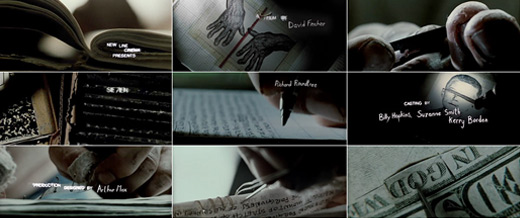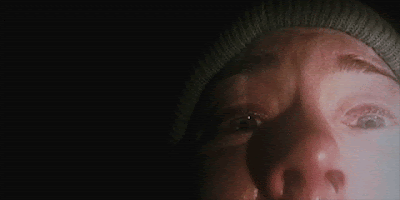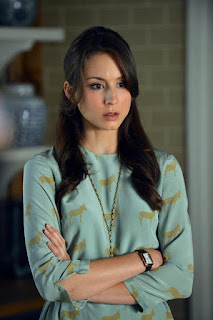Se7en
Carla Castagnetti
Horror Opening Analysis: Se7en ( 1995)
The opening sequence is edited to have a faded colour and uses low key lighting. This gives an eerie and uncomfortable atmosphere which implies that there will be some dark events foreshadowing the storyline. In the opening titles, the main actors and the film title are shown on screen, the font that is used appears disorderly and scratchy, due to its abstract placement within the frame making it appear uneasy on the eye. This also convey a sense that the antagonist is out of place in society, perhaps causing him to scheme in the way we assume from the mise-en scene.

Extreme close up shots are consistently used throughout the scene to focus on many objects such as books, pens and paper as well as those that fit the conventions of horror for example blood stained fingers, blades and guns. Contrastingly, this scene does not use any long shots or wise angle shots as this would therefore reveal location and therefore more to the antagonist's identity thereby conforming to the genre of the film, creating a sense of enigma. This opening, being a thriller conforms to stereotypes as the images are uneasy on the eye and portray an uncomfortable sense of insanity, experienced through the tone. This is due to the fact that from the spine-chilling mise-en scene, it suggests that whoever the hand belong to is writing what we assume to be his experiences or future schemes. Moreover, the blood stains denote murder, leaving the audience curious as to who this antagonist has presumably hurt. Similarly, the antagonist is not revealed throughout the scene, this lack of identity creates a sense of mystery and uncertainty to the scene; conventional of a mystery thriller. From looking at this scene, the mise-en-scene portrays the idea that the antagonist in this scene is a trophy killer as he has an overwhelming amount of abstract supplies that we assume could not all belong to him and pictures of presumably his suspects.
 .
.
The inconsistent timings, framings, colours and angles are all paired with fast pace straight cuts and jump cuts to increase the pace of the opening which adds to the thriller aspect. Moreover, immediately the opening close up shot is paired with a non-diegetic bass sound that is parallel to what is happening in the scene as it is haunting, the audience would subconsciously therefore associate this sound with thunder and lightening, a convention of horror. In this shot the hand is out of focus, paired with the sound of a non diegetic synthesised beat sound to signify that this character is alone and perhaps does not want to be caught, adding the mystery of this thriller genre. These sounds play in time with the hand flickering the pages of the book, which is in itself perhaps symbolic of The Good Book which is paired with the white writing, symbolic of innocent lives or connoting the antagonist to be a religious person. In addition, frequently throughout are the title credits which are written again in white with a juxtaposing black background, symbolic of the contrast between good and evil. As well as the fact that the font is similar to the handwriting of a child, conveying the unbalanced mind-set of the antagonist.

Extreme close up shots are consistently used throughout the scene to focus on many objects such as books, pens and paper as well as those that fit the conventions of horror for example blood stained fingers, blades and guns. Contrastingly, this scene does not use any long shots or wise angle shots as this would therefore reveal location and therefore more to the antagonist's identity thereby conforming to the genre of the film, creating a sense of enigma. This opening, being a thriller conforms to stereotypes as the images are uneasy on the eye and portray an uncomfortable sense of insanity, experienced through the tone. This is due to the fact that from the spine-chilling mise-en scene, it suggests that whoever the hand belong to is writing what we assume to be his experiences or future schemes. Moreover, the blood stains denote murder, leaving the audience curious as to who this antagonist has presumably hurt. Similarly, the antagonist is not revealed throughout the scene, this lack of identity creates a sense of mystery and uncertainty to the scene; conventional of a mystery thriller. From looking at this scene, the mise-en-scene portrays the idea that the antagonist in this scene is a trophy killer as he has an overwhelming amount of abstract supplies that we assume could not all belong to him and pictures of presumably his suspects.
 .
.The inconsistent timings, framings, colours and angles are all paired with fast pace straight cuts and jump cuts to increase the pace of the opening which adds to the thriller aspect. Moreover, immediately the opening close up shot is paired with a non-diegetic bass sound that is parallel to what is happening in the scene as it is haunting, the audience would subconsciously therefore associate this sound with thunder and lightening, a convention of horror. In this shot the hand is out of focus, paired with the sound of a non diegetic synthesised beat sound to signify that this character is alone and perhaps does not want to be caught, adding the mystery of this thriller genre. These sounds play in time with the hand flickering the pages of the book, which is in itself perhaps symbolic of The Good Book which is paired with the white writing, symbolic of innocent lives or connoting the antagonist to be a religious person. In addition, frequently throughout are the title credits which are written again in white with a juxtaposing black background, symbolic of the contrast between good and evil. As well as the fact that the font is similar to the handwriting of a child, conveying the unbalanced mind-set of the antagonist.
 In what some would argue is the most chilling frame of this opening is the one of the hands, here, chiaroscuro lighting is used to perhaps signify darkness taking over the mind-set of the antagonist, symbolic of his purity being corrupted. As well as the frame whereby the antagonist is cutting skin of his fingertips to again denote the idea that he wants to keep his identity hidden. However coupled with the mise-en-scene and immense amount of drawings and writings that this antagonist has put together, this frame therefore adds to his psychotic and obsessive behaviour.
In what some would argue is the most chilling frame of this opening is the one of the hands, here, chiaroscuro lighting is used to perhaps signify darkness taking over the mind-set of the antagonist, symbolic of his purity being corrupted. As well as the frame whereby the antagonist is cutting skin of his fingertips to again denote the idea that he wants to keep his identity hidden. However coupled with the mise-en-scene and immense amount of drawings and writings that this antagonist has put together, this frame therefore adds to his psychotic and obsessive behaviour. 


Comments
Post a Comment